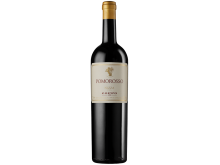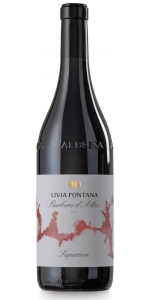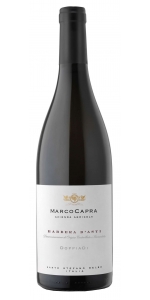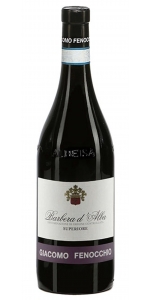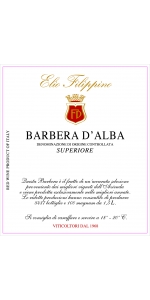Coppo Pomorosso Barbera d'Asti Superiore Nizza 2017
Livia Fontana Barbera d'Alba Superiore is made from 100 percent Barbera.
Organoleptic characteristics: intense ruby red color. Fresh and intense aromas with currants and berries notes. Warm, full, rich and persistent taste, full body. Suitable for long aging.
Excellent accompaniment to warm appetizers, rich first courses, red meat and the medium-seasoned cheeses.
Capra Marco Doppiadi Barbera d'Asti is made from 100% Barbera.
Color: very deep bright ruby red with violet hues.
Bouquet: intense and persistent, pleasantly fruity and reminiscent of plums and black cherries.
Flavor: vinous, full, pleasantly fresh and generous.
Suitable as an aperitif with appetisers and sliced meats, it is perfect throughout a meal. it is perfect with pasta dishes featuring tagliatelle and ravioli, as well as with meaty main courses, such as stews and roasts. Interesting with medium-mature cheeses, with Toma and Pecorino.
Fenocchio DOC Barbera d'Alba Superiore Bussia is made from 100 percent Barbera.
The color is a deep ruby red with garnet reflections. It has a rather intense bouquet, with scents typical of the vine and a full bodied and dry flavor, with a distinct and pleasing acidity. It becomes mature with aging, acquiring a full and balanced flavor.
Parcel is 2.5 hectares (6.2 acres) planted at 300 meters above sea level.
It pairs well with red and white meats, tagliatelle pasta and cheeses.
Filippino Elio Barbera d'Alba Superiore is made from 100% Barbera.
This 100% Barbera shows an intense fruity bouquet with subtle vanilla and toasty notes. Full and spicy flavors, and a good body.
The grapes are pressed and the stalks are removed. The must ferments at about 26°C for 6-9 days. After racking, before the end of fermentation, the new wine is put in 225 liter Allier barriques for long months, depending on the vintage and the wine’s structure. It is subsequently moved into stainless steel vats to rest for some months before bottling.
Filippino Elio Barbera d'Alba Superiore is made from 100% Barbera.
This 100% Barbera shows an intense fruity bouquet with subtle vanilla and toasty notes. Full and spicy flavors, and a good body.
The grapes are pressed and the stalks are removed. The must ferments at about 26°C for 6-9 days. After racking, before the end of fermentation, the new wine is put in 225 liter Allier barriques for long months, depending on the vintage and the wine’s structure. It is subsequently moved into stainless steel vats to rest for some months before bottling.
Livia Fontana Barbera d'Alba Superiore is made from 100 percent Barbera.
Organoleptic characteristics: intense ruby red color. Fresh and intense aromas with currants and berries notes. Warm, full, rich and persistent taste, full body. Suitable for long aging.
Excellent accompaniment to warm appetizers, rich first courses, red meat and the medium-seasoned cheeses.
Coppo Pomorosso Barbera d'Asti Superiore Nizza 2017 is made from 100% Barbera.
Pomorosso can be considered Coppo’s landmark. It’s a cornerstone of Barbera’s history, a wine that played an important role for the international recognition of Coppo. 100% barbera, Pomorosso always respected the most strict rules of production, even way before they were written down for “Nizza docg”. The soil is marine sediment and rich in minerals, which gives the wine finesse, minerality, and longevity.
Review:
This is one of those fortunate wines that enjoys special recognition as its own brand, Pomorosso. It's also one of the pioneers of the recently minted Nizza denomination. Coppo has been making Pomorosso since 1984 and has learned a thing or two along the way. The 2017 Nizza Pomorosso is an excellent edition from a vintage that mistreated many of Piedmont's other varieties because of scorching summer heat. However, Barbera loves the heat, and this wine has absorbed every last sunbeam, adding to the wine's inner richness and concentration. Dark fruit, black currant, spice, tobacco and barbecue smoke rise from the bouquet. The aromas are big, but so is the wine's hold and grip on the palate. I taste the heat (this bottle declares a 16% alcohol content), but fresh acidity keeps the wine from feeling too heavy or ripe.
-Wine Advocate 93 Points
The history of Coppo winery is inextricably wound with the wine history of Piedmont. It is closely linked to the development of the city of Canelli, known as the capital of Italian sparkling wine and one of Italy’s most important viticultural centers today.
Coppo’s history is one of tradition and courageous vision for the future, of sacrifice and innovation. It is a story of the unconditional love that Coppo has for their vines’ origins, for varieties that have always been cultivated in Piedmont, and for old family traditions.
The origins of the winery date back to 1892. For over 120 years, the family has remained the sole owner. Since the very beginning, the Coppo family has managed estate vineyards and bottled their own wine under the name of Coppo, making it one of the oldest family-run wineries in all of Italy.
In fact, in 2012, Unioncamere added the winery to the national register of historical businesses, highlighting its uninterrupted activity for over a century in the commodity market.
Piero Coppo was the head of the family and founder of the core that became today’s modern winery. He was known for his finely-tuned palate and infallible nose. Above all, he was known for his strong sense of ethics with which he managed all his activities. He strived for perfection down to the last detail, personally checking on all phases of work, from the vineyards to pressing, and from the winemaking to bottling and aging in a near-obsessive search for absolute quality without compromise.
At the time, Canelli was an important market for Piedmontese grapes, and a fundamental juncture for vine growers and winemakers. It was in this city in the 1800s that Coppo made the first Italian spumante with secondary bottle fermentation. This method is the same used to make Champagne; thus, the wine was called Moscato Champagne. Coppo’s intuitive move was destined to change Italian wine history and cast the city of Canelli in a role of noteable importance as it proved itself worthy of developing an international wine industry at the forefront of change.
In Canelli in 1913, Piero married Clelia Pennone, the heir to the Pio Pennone winery, a “leading and renown” producer and exporter of wines that had already been active for two generations. Thus the Pennone winery was added to Coppo in the center of Canelli between Via Giuliani and Via Alba, and today comprises the central seat of the winery.
In this very winery at the end of the 18th century, the galleries and corridors known today as the Underground Cathedrals were excavated from the tuff stone under the earth. Because of their historical value and unique, architectural beauty, these underground cellars have been recognized as a Unesco World Heritage site.
Passing through the underground cellars, one may walk underneath the entire length of the hill, finally reaching the point where the spumanti rest on their lees. Here, at the end of the long lines of bottles, pass through an ancient wood and cast iron door to emerge directly on the other side in the garden of the magnificent art nouvea villa that Piero bought the same year he was married.
At the beginning of the 20th century, the winery’s production ranged from sparkling wines to classic Piedmontese reds, among which Barbera stood out. Coppo also produces Vermouth, an aromatized wine (often Moscato di Canelli) that became fashionable in the 19th and 20th centuries. Vermouth is one of the world’s most popular cocktail ingredients, and it definitively contributed to the wealth and fortune of Canelli.
Wine production in the first decades of the 20th century was profuse and frenzied. Wine and sparkling wine sold fast in Italy and around the world, leaving the wineries on carts pulled by oxen and encased in 200-liter, oval Bordeaux barrels. Wine was exported mostly in South America and to the United States, where it was sold in bulk and in demijohns.
- back
Yalumba The Signature Cabernet Sauvignon Shiraz is made from 52% Cabernet Sauvignon, 48% Shiraz .
Encompassing everything the Hill-Smith family stands for and the perfect representation of Yalumba’s history and ethos, The Signature is a sentimental favorite. A classic Australian blend of Cabernet Sauvignon and Shiraz, the first vintage release of The Signature was in 1962. Since then, this outstanding wine has acknowledged more than 57 Signatories; people who have enhanced the traditions and culture of Yalumba.
Seductive and alluring florals, cool mints, red pomegranate with fine blackberry fruits and dark cherry aromas. The palate is delightfully generous with dark red cherry fruit that merges into ironstone tannins. A medium to full bodied wine with a long, flowing tannin profile.
Review:
A full-weighted, archetypal Aussie blend. Cabernet and shiraz, both from the Barossa. The top wines of Yalumba have undergone considerable refinement in recent years. The tannins, better managed; the fruit, more restrained; the oak, judicious. Here, an example. Fresh and lithe. Scents of anise, bay leaf and kirsch, with a nourishing core of beef bouillon. An expansive sweetness grows in trajectory, with a douse of menthol at the finish. Drinkable now, but best from 2025.
-James Suckling 94 Points
The Prisoner Wine Company The Prisoner Red Blend is made from a blend of Zinfandel, Cabernet Sauvignon, Petite Sirah, Syrah, and Charbono.
Bright aromas of ripe raspberry, vanilla, and coconut give way to flavors of fresh and dried blackberry, pomegranate, and vanilla, which linger harmoniously for a smooth and luscious finish.The Prisoner Red Blend was inspired by the wines first made by the Italian immigrants who originally settled in Napa Valley. The Prisoner is now the most recognized red blend, leading the resurgence of interesting blends by incorporating Zinfandel with the unlikely mix of Cabernet Sauvignon, Petite Sirah, Syrah, and Charbono.
On the nose, dried blackberry, dried açai berries, and hints of cedar and tobacco leaf are accented by sweet spices of clove, cinnamon, and nutmeg. Flavors of ripe dark cherry, blackberry coulis, and hints of anise linger harmoniously for a soft, vibrant finish balanced by ripe tannins.
Chef Brett recommends pairing The Prisoner Red Blend with Kalbi Short Ribs or Chicken Mole Tostada.
Vineyards: When you outgrow winemaking tradition, you must forge your own path. And we did. The Prisoner exists because of the collaboration with our growers, many of which have been with us since the very beginning—from the Solari Family Vineyard in Calistoga, where old school sensibilities meet new techniques, to the Korte Ranch in St. Helena, a vineyard whose diligence outlasted the Prohibition and has sustained four generations.

